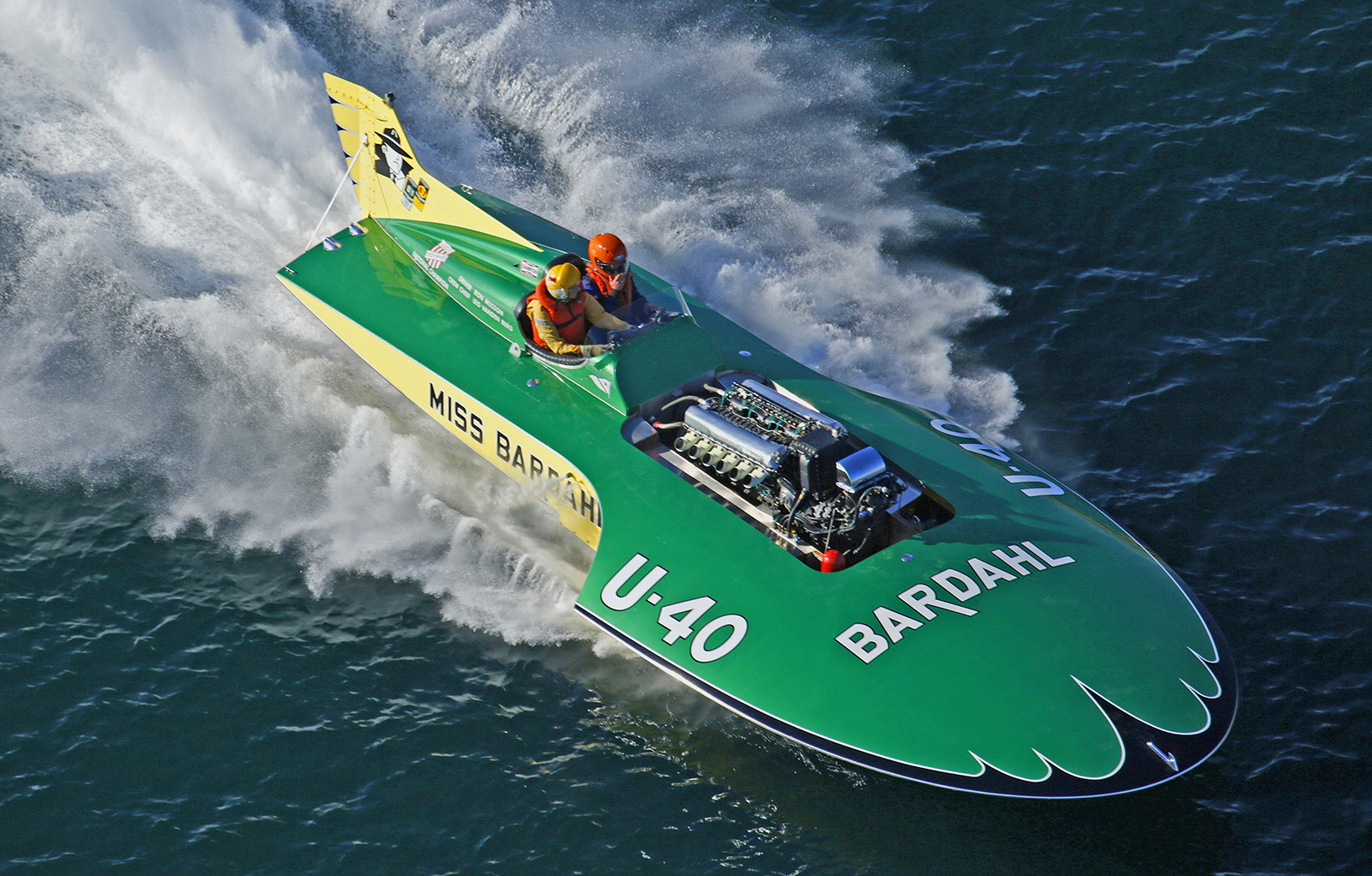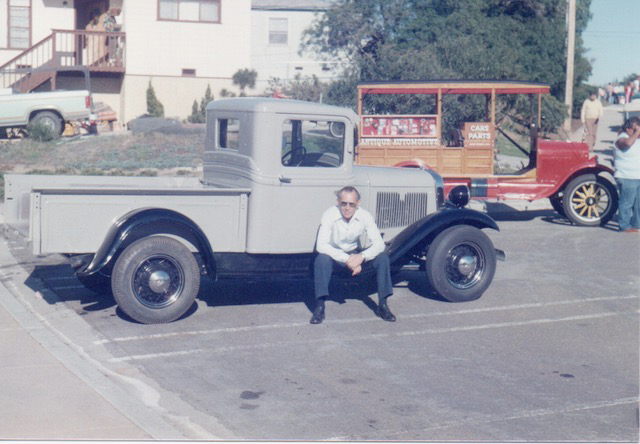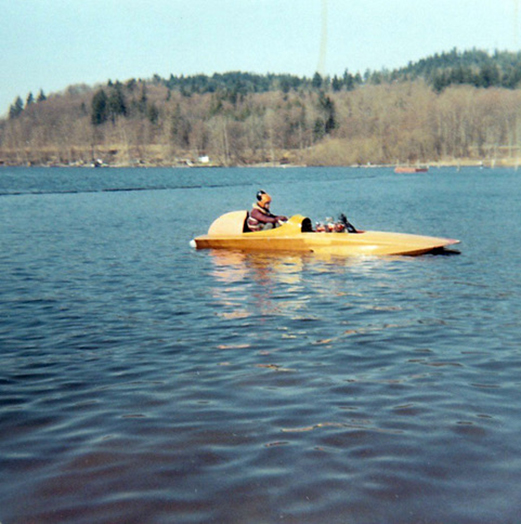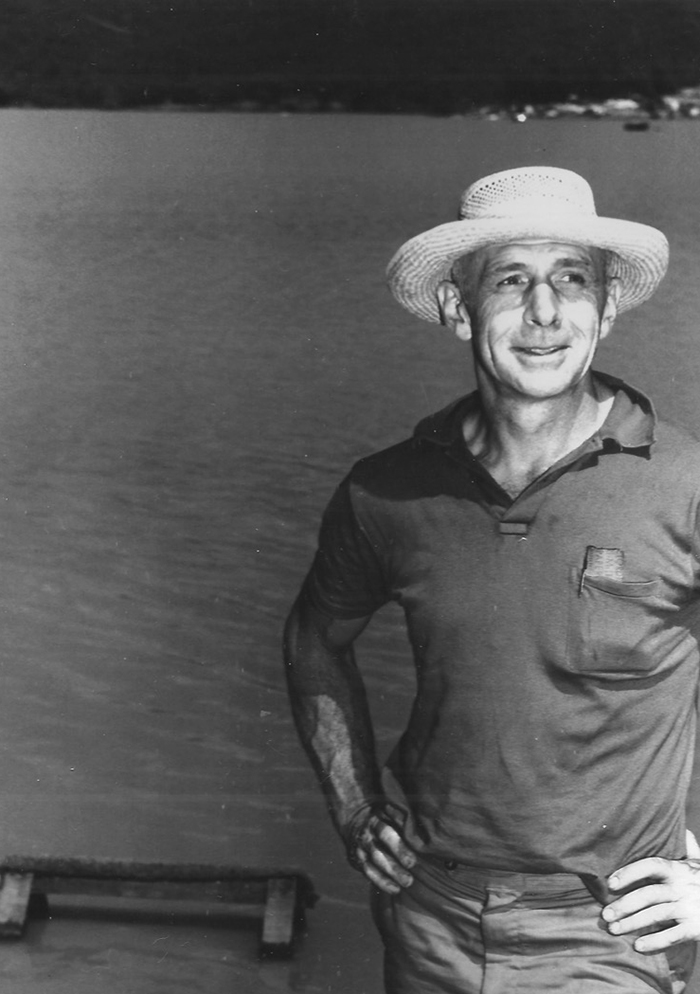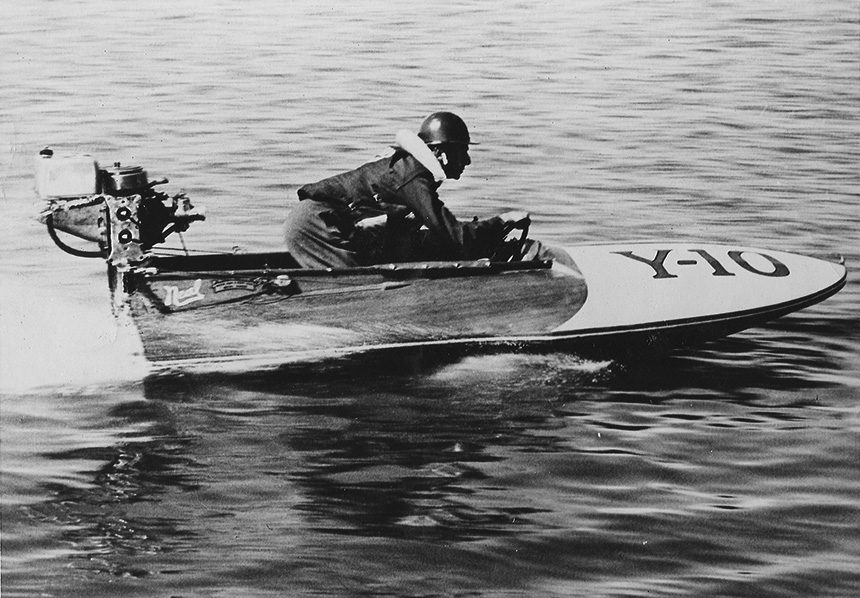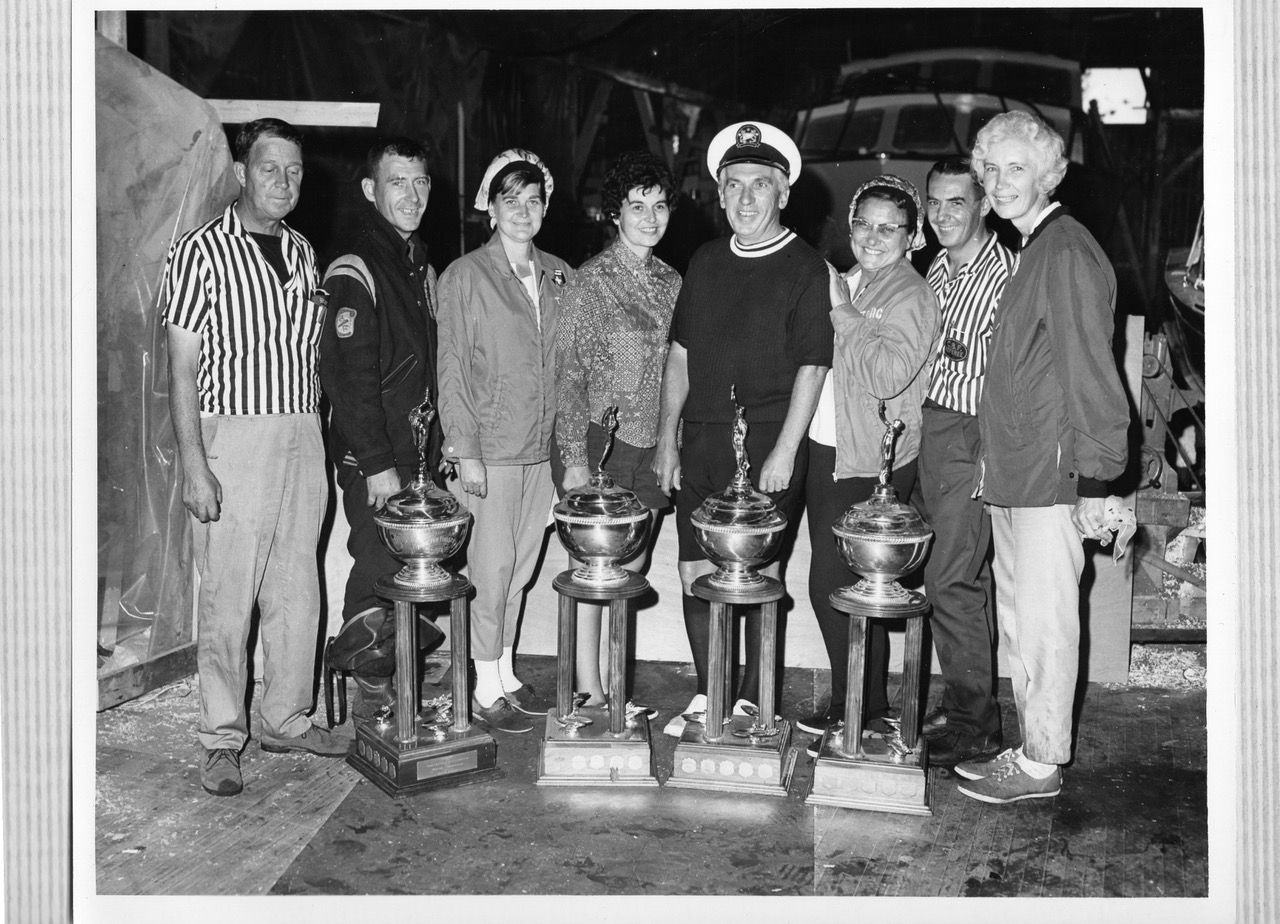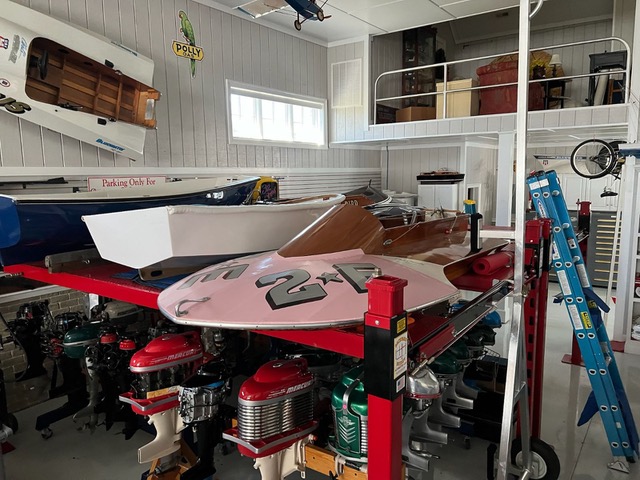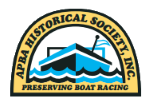Discussing Propellers with George Lockhart
July 29, 2023 - 2:27pm
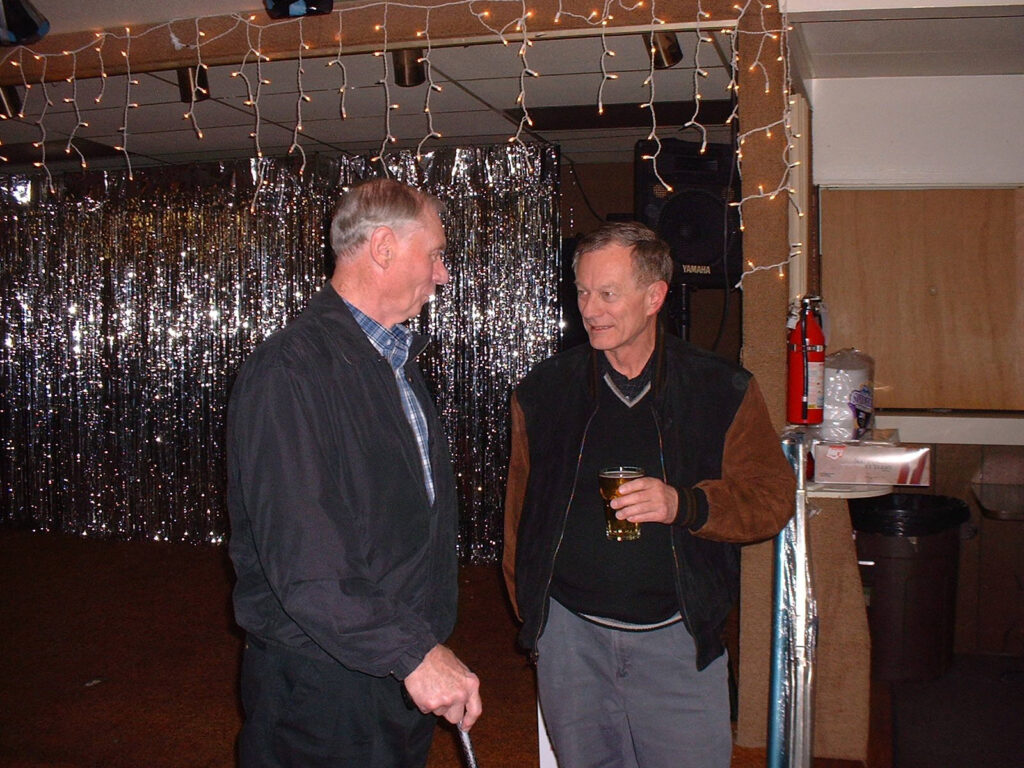
George Lockhart (L) at the SOA 75th Anniversary Meeting in 2004, having a chat with Mike Jones. Gleason Racing Photography
By Craig Fjarlie
George Lockhart of Tacoma, Washington, spent much of his life working on racing propellers. He briefly raced outboards, but soon discovered his true passion was working in his shop, pounding, filing, and polishing propellers.
Lockhart was born in 1933. He contracted polio when he was 14, but recovered. In school, Lockhart took classes in metal shop and sheet metal drawing. In his professional life, he worked at Tacoma Brace and Limb, beginning in 1952. The following interview was conducted at his home in August, 2014, when he had retired from both his job and his propeller business.
You raced in a class called A Standard?
Yes, A and B boats. They were 20 cubic inch, the Mercury Hurricane 10 and the KG-4. The Quicksilver lower unit was the only difference. I did get a Quicksilver and I raced with it too, but around here we were using the standard lower unit. They’re not as fast, but it doesn’t matter; the competition is always the same.
So, with the right propeller you could get them up…
Oh, definitely. We used to race around Vashon Island, Fox Island, marathons. I didn’t like those because I got beat up pretty good. Tough ride. But I won 20 trophies in three years, so I was pretty happy with that.
Who did you buy your first boat from?
A guy by the name of Jack, I can’t think of his last name. I borrowed his boat and then built my own.
Was it a hydro or runabout?
A runabout. They were all runabouts. There weren’t any hydros running.
And you built it here at home?
Yeah. All mahogany. It was a pretty cool-looking boat. Named it Crybaby.
Where did you get your first engine?
From Jack Leek, at Narrows Marine.
Did he help you set it up?
No, I just bought it from him. There was a fellow here from Texas, Jack Thompson. In fact, he was George Thornhill’s father-in-law. He was a real engine man. He went through the engine for me. I actually dumped it, I think around Bremerton. Dumped it and blew the case on it. Jack put it back together for me. He was a good engine man. He ran NOA down in Texas a lot, all the alky stuff. He worked with a lot of guys around here.
You raced with the Tacoma group, but there was a separate group in Chehalis. Did you ever run with them?
Oh, yeah. They were a different group. What happened was their group just got too small and they donated all their treasury to the Tacoma Boat Racing Association. Just kind of merged. Then Tacoma Boat Racing did that, too. We weren’t involved with Tacoma Inboard Racing. They had Mike Raich and a couple others from down in Aberdeen. They were fast—real good. I used to take my equipment out on the beach with Mike and hammer props all day. He’d test them. Kept me and him busy.
Did he run on salt water, then?
No, Mike didn’t like putting his boat in salt water. But he had learned to drive on the Wishkah River in Aberdeen. Of course, it’s not very wide. It taught him how to steer a boat at high speed. Very good driver. He was friends with Mike Jones. And Mike (Raich) set a couple records at Lake Lawrence. He did well at the Nationals too. One time when he was at the Nationals, he got into a collision with another boat. Took off his whole left sponson. He finished the race with only one sponson and still ended up third. There were pictures of him in Boat Sport magazine when he came in. They had a bunch of guys in the water to grab the boat as soon as he shut off the engine, to keep it from sinking.
How did you start doing propeller work?
At my job, I worked with metal. I did all the metal braces, and other kinds of milling work with metal. I looked at those props. Eddie Wright helped me a little bit with it. He was pretty secretive because he was racing, too, and doing his own propeller work. I can still remember how the acceleration improved so much! I once finished a race and was just sitting, tips of my fingers on the steering wheel. For some dumb reason I squeezed the throttle, and got thrown back against the engine. If it weren’t for the engine, I’d have been in the water. It punched that fast. It certainly didn’t do that before I worked on it. So, that encouraged me.
Did you start buying all the tools, the hammers and pitch blocks and all?
I had to make all of those myself.
Did you use whatever was available first?
Right. Lead blocks is what I started with. Pitch blocks came quite a bit later after that. I’d get a cast of the propeller, take it to the foundry and then cast it. Then I had to finish it the way I wanted it. They didn’t have pitch checkers then. You had to make your own. Ed helped me—told me how to figure out the pitches and how they worked. I can still remember, we didn’t even have calculators in those days. I had to sit there and figure out every pitch. It works with the pi and the diameter, and the inches of pitch is where it is. The diameter plus the pitch gives you the angle. Most people just kind of know about it. I remember Ron Anderson made a pitch checker, and showed it to me. The thing was set to go on the propeller at a 15-degree angle. I asked him, “Why did you do that?” He said, “I don’t know why. It’s very difficult to figure out all the pitches with that 15 degrees.” I said, “Well, actually, straight down across is zero pitch. You don’t have to put that 15 degrees in.” He kind of looked at me and said, “Oh.”
I ended up with Terry Troxell’s pitch checker. I gave a talk at one of the inboard meetings one time and he had it there. It worked fine; there was nothing wrong with it at all. I got kind of a kick out of that. Had to figure out the 15 degrees or something. Another thing with props is rake. A lot of people don’t really understand it. They kind of know what it is, but don’t really understand what it does.
It’s the angle that the blades come off the hub.
True, but it’s more than that. It’s measured off the shaft, same as the hub. If you were to put a prop on your boat and have it the way it’s running, you put a carpenter’s square on the bottom blade, hanging straight down. That will show you the line that technically is the way the prop would drive the boat. Raise more rake, it would raise the nose up; or less rake, it would push the nose down. In an outboard, six degrees is just about as much as you could possibly put into it. Some of them, like the Service class, zero rake works best, especially on a right-hand propeller. The Service ones run straight. They just don’t like rake at all, and it’s opposite rotation.
When you started doing propellers for other people, is that what encouraged you to stop racing?
Right, exactly.
You hung up your helmet.
Just strictly did the props. I gotta laugh, because I used to charge $5.00 to work on a propeller. Then I got kind of high-headed and I wouldn’t even open the shop door for $5.00. I don’t think I ever really overpriced my work. People think I worked on the Unlimiteds and made a ton of money, and I didn’t. For $100 I’d work on their propeller. I did a lot of work. I remember Jim Lucero. I left three propellers outside my shop door. He was a night guy and he’d come down at midnight and pick up the props. They were $15,000 each, just sitting outside, but nobody bothered anything. I just liked that story. But I didn’t make anywhere near that kind of money.
Mostly, people brought their existing propellers to you? Did you start to do your own casting?
Well, I did some. Doc Collins—he’s passed away now—I did all his finish work for years. Ron Jones, the same thing. They would make the castings and I’d do all the finish work for them.
Did you do some work for Staudacher, too?
Jon Staudacher, yes. He did well. They call them 5 Litres now; they were 280s in those days. Staudacher was a neat guy. I did quite a bit of work for him. I had a picture in the shop of three boats in a row, all 225s. One was a Jones, one was a Karelsen, and one was a Staudacher.
When you branched out from outboards to inboards and other classes, you must have needed more equipment.
Oh, definitely. I actually built my own belt sander and buffer. In those days, it was really difficult to buy anything that would be suitable, because working on the propellers you needed contact wheels that were fairly soft. I had several different diameters of them and they were interchangeable. Just take an Allen wrench, open it up, slide it in, tighten it down, change the belts.
I used the disc sander only on the inboards and Unlimiteds. You couldn’t use it on outboards because the rotation was wrong. You catch it, it would tear it all to pieces. There were just steps I had to take. Run Bear-Tex wheels and everything else. I started out by changing the pitch. I had to heat it up on a pitch block or whatever way I did it. I had to first grind with a real coarse grit, like 36 grit. That got rid of the material that I didn’t need, that sort of thing. Then I’d keep stepping down like to a 120 grit and then the Bear-Tex wheel, and then I’d polish it.
And what is a Bear-Tex wheel?
It’s a brand of abrasive wheel, but it’s very fine. You could use that as a finish if you wanted. Most guys like ‘em shiny, so we had to polish with a buffer. Ron Anderson is the one who got me into Thistle buffing wheels. Most use a cloth, but the Thistle one is more aggressive and gives a very nice finish, and a lot quicker. I buffed like the guys at the chrome plating shops, and that helped a lot. Get the finish on the stuff—that’s important. And balancing—you have to have rails that are absolutely level without a wave. I had to have a mandrel for each shaft diameter. The inboards, in those days, were all tapered. You had to make the taper thing. I got a lathe and made my own. I’m not a machinist but I can run a lathe (laughs). But I made my own, just about everything. I had to.
You mentioned Ron Anderson going to 3-blade props, one of the first.
Very first that I ever heard of for racing.
What encouraged him to go to a 3-blade?
Well, I don’t really know why he did it. Being the sharp guy that he is, he had an idea, and when you stop and think about it, it’s pretty common sense now. If you have two blades, you have one in the water and one’s way up in the air, not doing anything. But a 3-blade, there’s one entering, one leaving, and one waiting to come into the water. The one thing I’ve learned is you think of the rotation one blade at a time. It’s the only logical way to look at them, because that’s the way they’re running, one blade at a time. Thinking about 7,500 rpm is not the way to look at it. Think about that thing going through the water one blade at a time. You’ll accomplish a lot more if you do that. So, blade shapes are extremely important. I used to keep a pattern of every one I did. If I had to duplicate it, I could. Worked out pretty well.
Some years ago, Bob Wartinger mentioned that 3-blades are more stable, because something is always in the water.
Definitely. They go through the turn way better. They aren’t necessarily so terribly much faster in a straight line than a 2-blade, but they are way more stable and it will actually accelerate faster. But nowadays, even in a straight line, they are faster.
In about 1957 or ‘58, the Unlimited Miss Seattle tried a 3-blade prop, but they couldn’t seem to make it work. Al Benson was involved with that and he had raced outboards. The Unlimiteds all stayed with 2-blades until quite a bit later.
I think the reason was with the lift, because even with a 2-blade they had trouble with that. Lucero and I would have some real sessions out there in the shop and that’s what I came up with. Everything needed more rake. A lot of them I had to grind it into them and boy, was that a chore. They were just too thick at the hub and it could bend. You know, there’s such a short distance. They’re only, what, 15 inches in diameter, 15-½? Well, if you’ve got a hub that’s three inches around, you don’t have much length. You bend it, it’s pretty hard to do. I would grind at the hub and work out toward the tip. They were so thick that I couldn’t get a quarter of an inch off at the hub, but had to keep it all straight, all the way through there. Boy, by then, that was a lot of work, holding those things up to the grinder. There was one time after they started running 3-blades, Jim Harvey and his crew chief came with a 24-pound prop. A wad of metal that I had to finish. Oh, I was tuckered out holding that thing.
Some boats run better with a round ear blade, some run better with a cleaver, and some it doesn’t seem to matter. Did you find there were specific kinds of propellers that worked better on some boats, and what that reason might be?
The straight back, the cleaver type, they’re a surfacing propeller. They’ll try to come up out of the water on their own, where the round blade, they’ll stay submerged. Now, you hardly ever see a cleaver on a runabout inboard. Even now, a lot of the outboards can run either way. George Woods came down here with his K-Boat. We worked on his propeller and he set a world record at 162 miles an hour, which is respectable. That, of course, was a long time ago. George was a great driver, and he loved those runabouts. He put on a great show when they used to run at Green Lake. But they were all round-bladed props for that type of runabout.
Sometimes cleavers had a greater tendency to “walk.” Somebody discovered if they rounded off the very tip of the blades, it would stop that process.
Definitely. Just as I mentioned earlier, it’s a surfacing propeller. It’s trying to come up out of the water. Another way to cure the walking is to put some more rake into it. That’ll help. But in the smaller classes I found that’s not a good idea. Rounding it off is doing exactly what you wanted, and there’s nothing wrong with it. You gotta cure that. I remember in OPC, they had a heckuva time with the boats blowing out. They’d be running down the chutes and just break loose. They’d just fall off plane. I found that more rake in those props cured that. Now, with the 2-blade and the D Stock Hydros, the old Michigans, they were good props but they would walk, too. And that was a big blade. They would go down the chute and spin out, go sideways. I found that trimming that back edge off cured that. Made all the difference in the world. Made it a good propeller, simple change like that.
When you started working on inboard props, do you remember what class was the first one you worked on?
Mike Jones kind of got me started on that. George Babcock had a boat, Record 7, and they wanted me to work on his propeller, so I did. George Henley drove it. They were at Green Lake and another fellow had Tool Crib. Both were 7 Litres. I still remember them coming down the backstretch side-by-side. Here’s two boats that I had props on. Not trying to pick one or the other because I liked both of them. They were running just about the same speed.
Lauterbach, remember him? He was still using the old conventional hydro. He sent me a prop. I worked on it and he set a world record with it. One thing I might mention about inboards is I was doing a lot of work for Ron Jones’s boats, and John Leach’s. I used to work for John on his 280. Five boats from here went down to Miami to the Nationals, in 280. All five of them finished 1, 2, 3, 4, 5, and they all had my props on them. I thought that was pretty cool. Well, that really increased my appeal to people from Florida. It made a difference.
So, you were doing work for people all around the country, then.
Oh, definitely, yeah. You know, I never advertised, ever. Word of mouth. And down there, a guy might put my name on their trailer or something, they always talked to each other and asked about that. It was interesting to come home from my day job and see where the next call was coming from. It was kind of fun. I had a call from Poland once, and London, England, and South Africa, and Australia. And from all over the United States. Did a lot of work for Jean Theoret up in Quebec. I used to have to send the props to New York. He would come down and pick them up, because he didn’t want them sent into Canada.
Maybe he would have had to pay duty on them, or something.
Yeah. It was just fun little things like that. I had to take a prop to the airport one time. The ticket people, gave them the prop and they had one of the flight attendants carry it aboard the plane, take it to California, ‘cause they wanted it for a race there.
One interesting thing, I’ve told everyone this who had a winning combination. You need four things: You need a good boat, a good engine, a good driver, and of course, a good prop. I’ll be darned if Chip Hanauer wasn’t on the air last year at the Seafair race, and said the very same thing. I did Chip’s first prop when he was nine years old. We’ve been friends all this time. When Bill Muncey got killed, his widow, Fran, took over the team and Chip came down here with her. Always interesting.
Did you ever work on drag boat props?
Yeah, and I always got a kick out of them because these guys, all they wanted to talk about was how many carburetors they had and how many high lift camshafts. They want to talk engines. It doesn’t matter what your engine is. It’s not going to do you any good if you don’t have something down under the water to push the boat ahead. Now, these guys are going fast, very fast. In those days they were kind of in their infancy around here. But overall, I was able to help them. I did a little bit of offshore work, but I didn’t like working on them. There weren’t enough around here to make much difference.
Things have changed a lot with the way propellers are made. They can take a big hunk of aluminum and just cut out the blades based on a computer program. How has it all changed since you were working on them?
Well, basically, they would only do that on the Unlimiteds. Rather expensive program. They use a stylus and they cut each one like you say, and they come out pretty accurate. They still have little bumps on them, but you just grind those off so they’re smooth and you’re done. You don’t have to worry about pitches or anything else.
That can all be programmed in.
Exactly. But still, once it’s made, you’re stuck with it, unless you grind it in there. With the Unlimiteds, you don’t do too much banging on ‘em because they’re so thick. But oddly enough, as thick as they are, they break. When you start turning them 13 grand and coming up out of the water and coming back it’s like banging the lid on a tin can. It actually can give. In testing with Mike Raich, I was about 10 feet away from where he would run by me because of the way the lake was. It was deep. I kept hearing this bap! bap! bap! bap! It took me a while to figure out it was the prop slapping the water. In those days it was 2-blades, you know. It made me think, if this thing ticks every time and water doesn’t compress, something’s going to give eventually.
Did you change some of your techniques, then?
The only thing I realized is the entrance pitch on the propeller is extremely important. When you’re a kid, you hit the water with a stick. You hit it with the flat side, the stick would go anyplace. But if it hits on the edge, a sharper edge, it goes through the water. Propeller does the exact same thing, so you want that entrance edge to come in real clean. The easiest way to get the propeller to behave itself is to trim that front edge. We trim a whole lot more than what you think you can. I remember one time Lucero brought a 2-blade down here and they were running over at Tri-Cities. I cut the front edge off that thing and he about had a cow when he looked at it. He tried it over there (Tri-Cities) and they set a course record on the first try. So then he didn’t think I was quite so crazy.
You started working on props in the 1950s. What has changed in 40 years? How have propellers changed, besides going to multiple blades? Consider the design of boats, inboards going to cabovers.
Made a lot of difference right there. One thing I always liked about the outboards, they were forever trying new stuff. When I started working on the inboards, they called the outboards “stringpullers.” They always looked down on the outboarders until they saw how fast they actually go for the small amount of power they have. Pretty soon they wanted to be doing it like the stringpullers. Their speed, with the small engines especially, is very impressive, I think. Now, bigger engines go fast, but they have a lot of power. The smaller engines, the stock classes, are very impressive how fast they go. One time I told Dave Heerensperger, the owner of the Pay ‘N Pak, “Your propeller doesn’t look any different from what these kids with the JU’s are running.” He didn’t like being compared to the little JU, but the fact is, they all work the same. There’s no difference between a small prop and a big prop. They technically all work identically, no difference.
Just the size.
Exactly, and the power. And with these outboards, they can roll the boat over pretty easily and change the bottom and make sure that it’s flat.
How do you feel about boat racing—the state of the sport?
Well, they don’t have as many boats as they used to have, but they are extremely fast. They really are. I really believe that the drivers from around here, Region 10, hold their own any place in the country. I was going to tell you about J. Michael Kelly. I used to work on props for his dad Jeff, and his uncle Pat. When Mike started driving, I was still doing props for them. J. Michael sent me a picture of the Unlimited and thanked me for all the props I’d done for his outboard stuff. I thought that was pretty cool. And he definitely is a good driver.
Oh, no doubt about it.
That’s why I say, we have some sharp guys out here.
One final item, you know some of the history about the record courses at Lake Lawrence. The site was established by the Tacoma club.
Frank Miles and his dad (who was an engineer) designed the course originally. They ran it for several years. Then the Tacoma club was breaking up and we asked Seattle Outboard if they would take it over, which they were happy to do. They’ve done a good job with it, they really did. People used to feel that they couldn’t set many records out there–something was wrong. But take a look at the people that come from all over the country to run at Lake Lawrence now. An awful lot of ‘em set records. They aren’t coming there if they’re not going fast. One day, there was a guy there by the name of Carl Holt, from Ashtabula, Ohio. I used to do work for him. Walked up to him and introduced myself, because we’d talked on the phone but never met. “Well, who’s doing your prop work?” He’s doing his own now. He’s doing a good job, because he did run and set a record there. I also met Bill Rucker and was chatting with him. He said, “I want to thank you for all the props you’ve done for me. You’ve really built some good props.” I was doing them for Doc Collins. Doc was giving him the propellers all the time. I didn’t even know that. All these success stories of his, I’d been involved and didn’t even know it.
It has been an interesting conversation.
I think for being an old outlaw racer, I got along pretty well with the APBA guys (laughs). But it was fun, running these boats. Going into the turn when there are 12 boats in the heat, looking behind me, I was pretty fortunate to be up in front. But I thought, “Man, better stay in the boat or you’ll be hamburger.”
When you stopped driving, did you miss it, or were you glad to not be in a boat anymore?
I wouldn’t say I was glad, but I was so busy and it was such an interesting thing to do the propellers that I just got involved in that, trying to help make them go faster. A lot of the guys gave me a bad time, but that’s fine, and pretty soon they wanted me to work on their propellers.
Thanks for your time.
It was fun.
Featured Articles
